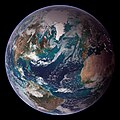Ecological footprint
An ecological footprint measures how much people take from nature. The footprint is then compared to the amount of natural resources nature can renew. The ecological footprint takes into account how much farmland, grazing land, forest area, and sea area it takes to provide everything people use through carbon dioxide intake.[1] More simply, footprint calculations answer the questions: how much nature do we have? And how much do we use?
When analyzing the world as a whole, humanity is using nature about 1.7 times faster than nature renews itself.[2] It is like using 1.7 planet Earths. Since people consume differently around the world, it is also possible to calculate how many planet it would take if everybody around the world consumed like a particular population. For instance, if everybody consumed like the Germans, it would take nearly 3 planet Earths. Expressed in area: The ecological footprint per world citizen is about 2.8 global average hectares per person while there are only 1.6 global hectare of biologically productive land and water per person on Earth. This means that humanity has already overshot global biocapacity by 70% and now lives unsustainably by depleting stocks of "natural capital"[3] and running on biocapacity deficits.
After this, it will shift into an ecological reserve because the biocapacity has been exceeded, and will be considered an ecological overshoot.
All this data is based on the 2020 assessment from Global Footprint Network, York University, and FoDaFo.[4] It uses 2017 data.
Ecological Footprint Media
The natural resources of Earth are finite, and are being used unsustainably given current levels of use.
Ecological footprint for different nations compared to their Human Development Index (2007)
Related pages
References
- ↑ Yasin, Iftikhar; Ahmad, Nawaz; Chaudhary, M. Aslam (2019-07-22). "Catechizing the Environmental-Impression of Urbanization, Financial Development, and Political Institutions: A Circumstance of Ecological Footprints in 110 Developed and Less-Developed Countries". Social Indicators Research. 147 (2): 621–649. doi:10.1007/s11205-019-02163-3. ISSN 0303-8300. S2CID 199855869.
- ↑ "Data Sources". Global Footprint Network. 2010. [1]
- ↑ "The Human Nature of Unsustainability".
- ↑ "Open Data Platform". data.footprintnetwork.org. Retrieved 2021-01-11.



